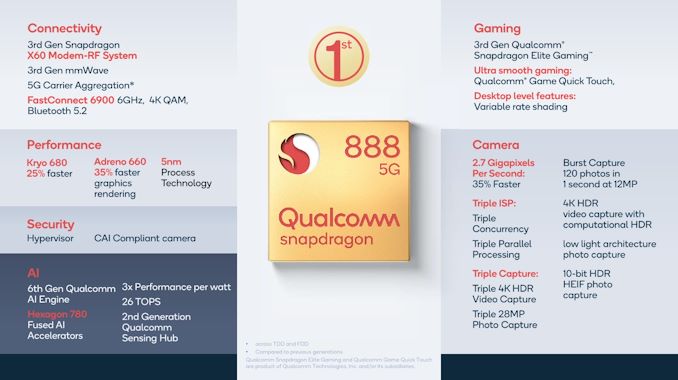Qualcomm Details The Snapdragon 888: 3rd Gen 5G & Cortex-X1 on 5nm
by Andrei Frumusanu on December 2, 2020 10:00 AM EST- Posted in
- Mobile
- Qualcomm
- Smartphones
- SoCs
- 5G
- Cortex A78
- Cortex X1
- Snapdragon 888
Conclusion & First Impressions
The new Snapdragon 888 is overall a very impressive package from Qualcomm, advancing the most important areas for which today’s smartphones are being used. 5G connectivity was the big new feature of 2020 SoCs and smartphones, and the new 888 platform represents the evolution and maturing of the new technologies that had been introduced in prior generations.
The big focus point of the Snapdragon 888 were clearly AI and cameras. The new Hexagon 780 IP block looks immensely impressive and to me seems like a major competitive advantage of the new SoC design – other vendors which aren’t as vertically integrated with their accelerator IPs will have to respond to Qualcomm’s new advancements as it seems like a major performance advantage that will be hard to mimic.
Today’s flagship smartphones have diminished ways of differentiating themselves from one another, with the cameras still being the one aspect where vendors still have very different approaches to their designs. Qualcomm’s push for a triple-ISP system in the Snapdragon 888 pushes the upper limits of what vendors will be able to do on their smartphones, allowing for a continued push for the smartphone camera ecosystem. Even for still-picture camera experiences, it seems that Qualcomm is expecting a more notable technology jump in 2021 as we see the introduction of new sensors and imaging techniques, enabled by the new SoC.
The new CPU configuration gives the new SoC a good uplift in performance, although it’s admittedly less of a jump than I had hoped for this generation of Cortex-X1 designs, and I do think Qualcomm won’t be able to retain the performance crown for this generation of Android-SoCs, with the performance gap against Apple’s SoCs also narrowing less than we had hoped for.
On the GPU side, the new 35% performance uplift is extremely impressive. If Qualcomm is really able to maintain similar power figures this generation, it should allow the Snapdragon 888 to retake the performance crown in mobile, and actually retain it for the majority of 2021.
The new Snapdragon 888 to me looks like a continuation of Qualcomm’s excellent execution over the last few years. Striking a balance between performance, power efficiency, and features is something that may be harder than it sounds, and Qualcomm’s engineering teams here seem to be focused on being able to deliver the overall best package.
Much like the Snapdragon 865, and the last couple of generations of Snapdragon SoCs before it, I expect the new Snapdragon 888 to be an excellent foundation for 2021’s flagship devices, and I’m looking forward to experience the new generation.
Related Reading:
- Qualcomm Tech Summit 2020: Day One LiveBlog (10:00 ET, 15:00 UTC)
- Qualcomm’s New 3rd Generation Snapdragon X60 5G Modem, Built on 5nm
- Qualcomm Announces Snapdragon 865+: Breaking the 3GHz Threshold
- The Snapdragon 865 Performance Preview: Setting the Stage for Flagship Android 2020
- Qualcomm Announces Snapdragon 865 and 765(G): 5G For All in 2020, All The Details
- The Snapdragon 855 Performance Preview: Setting the Stage for Flagship Android 2019
- The Qualcomm Snapdragon 855 Pre-Dive: Going Into Detail on 2019's Flagship Android SoC











123 Comments
View All Comments
RSAUser - Monday, December 7, 2020 - link
It shouldn't be, it's about 10% denser than TSMC 7FFP (127 vs 114), a far cry from TSMC N5 though (173).Zeratul56 - Wednesday, December 2, 2020 - link
Any word if/when this could end up in a 8cx platform. While probably short of the M1 it could make a windows on arm pc much more compellingdomboy - Wednesday, December 2, 2020 - link
I'm interested it see what the 8cx replacement based on the 888 will be like...colinisation - Wednesday, December 2, 2020 - link
Andrei/Ian - Any thoughts on the suitability of a 1+3+4 core CPU configuration as against a 2+2+4 config. I recall you guys did a deep dive on the state of threading in Android and it seemed that you had one or two main threads and the rest were low performance.Do you think this is still the case or do you think SoC vendors should be looking at increasing the big core count, given more multitasking on phones.
spaceship9876 - Wednesday, December 2, 2020 - link
No AV1 video hardware decoding support? You have to be kidding!ikjadoon - Wednesday, December 2, 2020 - link
Qualcomm has long loved the MPEG Industry. In 2017, Qualcomm was already hating on AV1: https://web.archive.org/web/20170611163031/https:/...In 2020, Qualcomm & Samsung are pushing for MPEG 5-EVC (presumably H.267?): https://www.qualcomm.com/media/documents/files/mpe...
So the upcoming codec wars (again): AV1, VVC (H.266), and EVC (H.267?).
However, most of the "big" hardware & software companies are backing AV1:
NVIDIA
AMD
Intel
Apple
Arm
Facebook
Cisco
Google
Microsoft
Netflix
Samsung (many fingers in many pies)
Adobe
Hulu
BBC
Alibaba
Broadcom
Realtek
Vimeo
Xilinx
Qualcomm already looking like chumps here. They literally use Arm's CPU cores on Google's operating system: Qualcomm's only serious work today is non-CPU IP: cameras, AI, etc. They're a little Texas Instruments?
Raqia - Wednesday, December 2, 2020 - link
CPUs, even high performance ones are now just much more commoditized; Qualcomm still does a lot of substantial work for the cache hierarchies and pre-fetchers which matter just as much as the core uArch. I'm always curious about CPU uArch and performance, but for a phone the other units matter more for the experience despite being less testable and prominent in most tech headlines.brucethemoose - Wednesday, December 2, 2020 - link
"Apple"Not so sure about that... the M1 skipped AV1 too.
RSAUser - Wednesday, December 2, 2020 - link
No, the M1 has AV1 decode, it's a larger A14.halcyon - Wednesday, December 2, 2020 - link
Yes, the lack of AV1 decode feels odd.